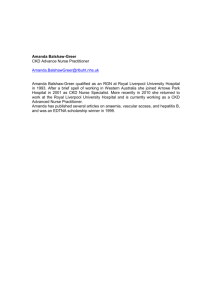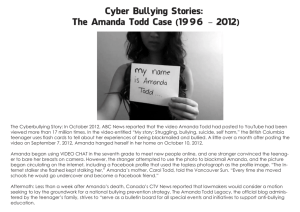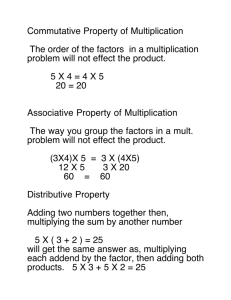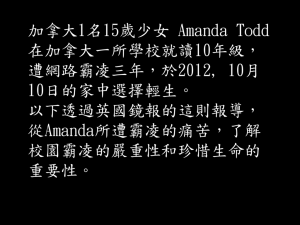Multiplication tool
advertisement
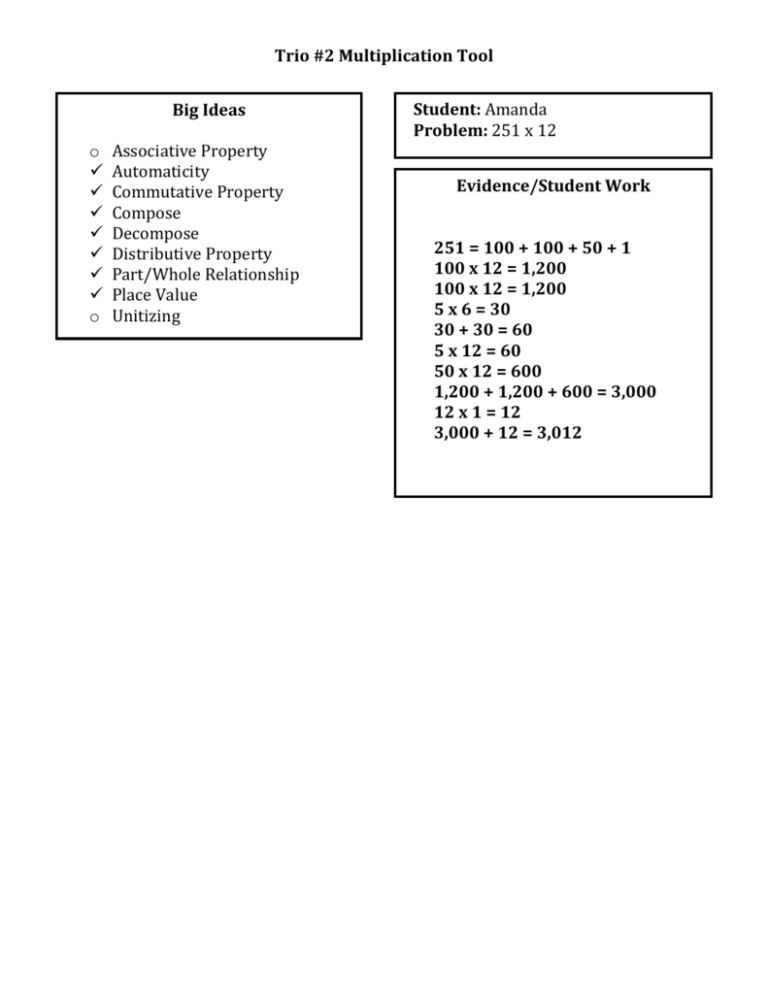
Trio #2 Multiplication Tool
Big Ideas
o
o
Associative Property
Automaticity
Commutative Property
Compose
Decompose
Distributive Property
Part/Whole Relationship
Place Value
Unitizing
Student: Amanda
Problem: 251 x 12
Evidence/Student Work
251 = 100 + 100 + 50 + 1
100 x 12 = 1,200
100 x 12 = 1,200
5 x 6 = 30
30 + 30 = 60
5 x 12 = 60
50 x 12 = 600
1,200 + 1,200 + 600 = 3,000
12 x 1 = 12
3,000 + 12 = 3,012
Strategies the Student Used
1.
2.
3.
4.
Friendly Numbers
Doubling Strategy
Known Fact
Repeated Addition
Analysis
Amanda starts by decomposing 251 into 100 + 100 + 50 + 1, in doing this she
sets herself up to use friendly numbers. The friendly numbers she uses are all
divisible by 10 (other than the 1). OK, it’s important to notice that she is able to
decompose into place value numbers—hundreds, tens and ones. She is also
demonstrating part/whole relationship when she says, “I thought of 251 as 100 +
100 + 50 + 1. Then I multiplied all of those parts by 12.” By multiplying all of the
separate parts by 12, she is using the distributive property. Amanda then
multiplies 100 x 12 and gets 1,200. We infer that Amanda knows something about
place value because she utilized zeros as placeholders to quickly multiply 12 x 1
and then tacked on the two zeros at the end of 12. Nice!! Then Amanda writes down
the same answer (1,200) for the second 100 x 12. Next she comes to 50 x 12. We
gather that she decomposes 50 into 5 x 10 and 12 into 6 x 2. We think this because
Amanda says, “I could just do 5 x 6, which is 30, and double it, which is 60.” Amanda
is using the commutative property during this part of the problem. The
commutative property allows her to move the numbers around and not worry about
the specific order they were originally in. Amanda knows that regardless of the
order she multiplies the numbers in, she will still get the same answer. Amanda pulls
the decomposed 5 and 6 from the parts of 50 and 12 to get the answer 30 by
knowing that 5 x 6 = 30 (known fact). Next she doubles 30 to get 60. She then says,
“If 5 x 12 is 60, then 50 x 12 is 600.” Much more clear here—good.
We infer that Amanda has to know doubling is the same as multiplying a number by
two because she uses repeated addition instead of multiplying 30 by the
decomposed 2. Good. She then adds 1,200 + 1,200 to get 2,400. This shows that
Amanda has a strong understanding of place value. We see this because she is
working with large numbers and does not lose track of where the zeros are to be
placed. Next she adds the 600 to get 3,000. Lastly Amanda multiplies the 12 x 1 to
get 12 by using automaticity and keeping track of her distribution of the 12 in her
first step. Her final step is adding the 12 to 3,000, again demonstrating a strong
understanding of place value by knowing where to align the digits. Amanda’s final
answer is composed to 3, 012, by adding all of the parts together.
Definitions
Associative Property: The order of the grouping of the factors in a multiplication
problem does not affect the product (Fosnot & Dolk, 2001, p. 36-37).
Example: 3 x 5 x 2
(3 x 5) x 2 = 3 x (5 x 2)
Automaticity: The automatic thinking (memorization) that occurs when a student
sees a relationship between two numbers. The answers to facts will be produced in
only a few seconds (Fosnot & Dolk, 2001, p. 85-86).
Commutative Property: The order of the factors does not matter when using
multiplication to find the product or total (Fosnot & Dolk, 2001, p. 36).
Example: 4 x 3 = 3 x 4
Decomposition: The breaking down of a number into smaller parts that are easier
to work with (Fosnot & Dolk, 2001, p. 36).
Example: 14+12
Decomposed 14 into 10 and 4 so 10 could be added
^ to 12 to get 22 then add the 4 to get the answer 26.
10+4 +12
10+12= 22
22+4= 26
Compose: Piecing back together the parts that were previously decomposed. {This
is the opposite of decomposition.} (Fosnot & Dolk, 2001, p. 36).
Distributive Property: Multiplying a sum by a number is the same as multiplying
each addend by the number and then adding the products (Fosnot & Dolk, 2001, p.
36):
Example: 9 x 5 can be solved by adding 5 x 4 and 5 x 5 or any combination of
groups of 5.
Doubling: Using addition to combine two of the same number, which is equivalent
to multiplying the number by two (Fosnot & Dolk, 2001, p. 41):
Example: 5+5=10
5×2=10
7+7=14
7×2=14
Friendly Numbers: Breaking down the original factors into factors that are easier
and more comfortable to work with (Fosnot & Dolk, 2001, p. 136-137).
Known Fact: Using facts that have been committed to memory.
Part/Whole Relationships: The knowledge that any whole number can be
decomposed into smaller parts that are easier to work with (Fosnot & Dolk, 2001, p.
37).
Place Value: The numerical value that a digit has by virtue of its position in a
number (Fosnot & Dolk, 2001, p. 48).
Repeated Addition: Adding the same number a specific amount of times, according
to the addends in the problem, in order to find the answer to a multiplication
problem (Fosnot & Dolk, 2001, p. 35).
Example: Finding the answer to 3 x 4 by saying 4 + 4 + 4 = 12
Unitizing: The understanding that numbers can be counted as single objects but
also as groups, simultaneously (Fosnot & Dolk, 2001, p. 11).
Example: Six can simultaneously be one, one bag of six cookies.
These definitions now have clarity and precision—well done!
Reference
Fosnot, C.T. & Dolk, M. (2001). Young mathematicians at work: Constructing
multiplication and division. Portsmouth, NH: Heinemann Press.


